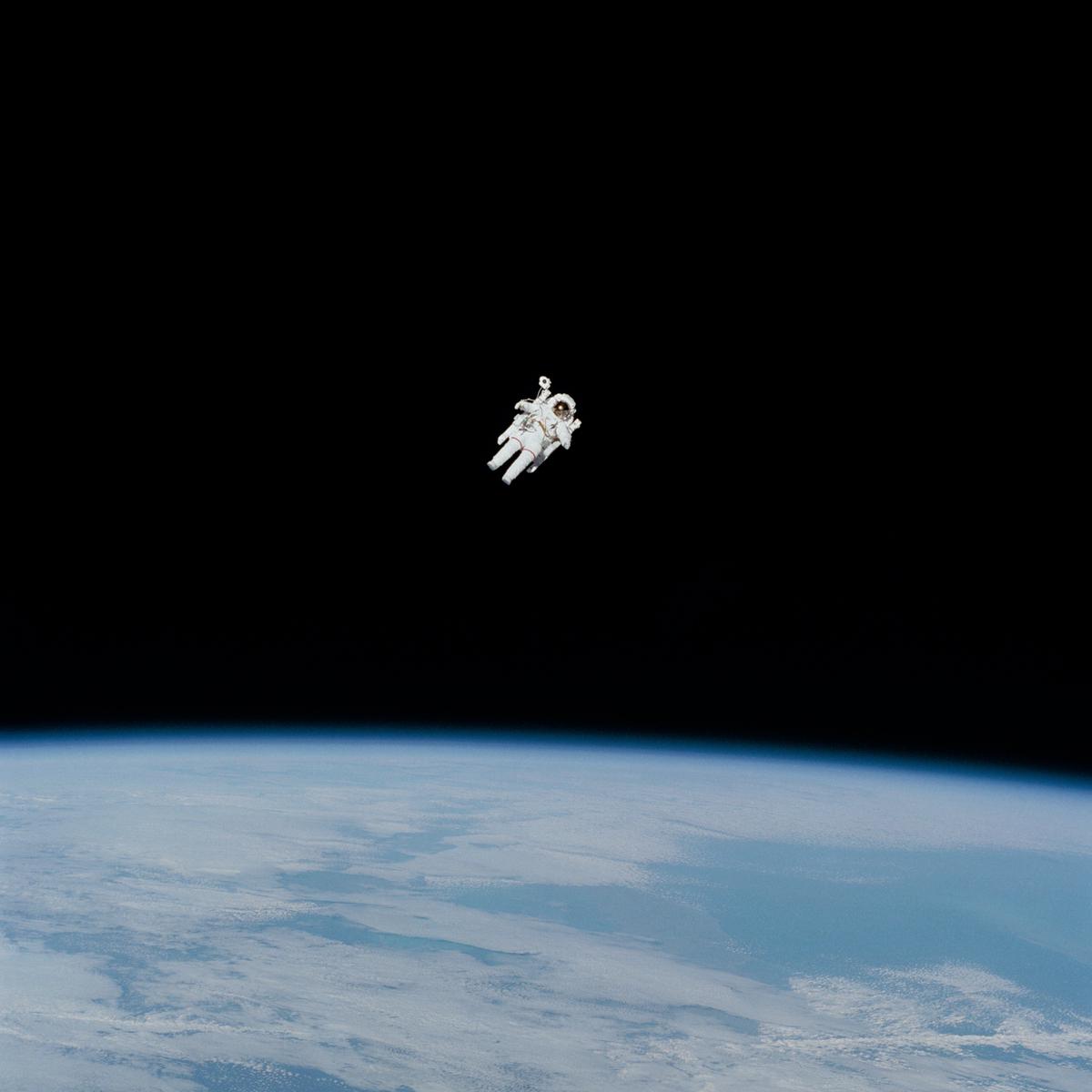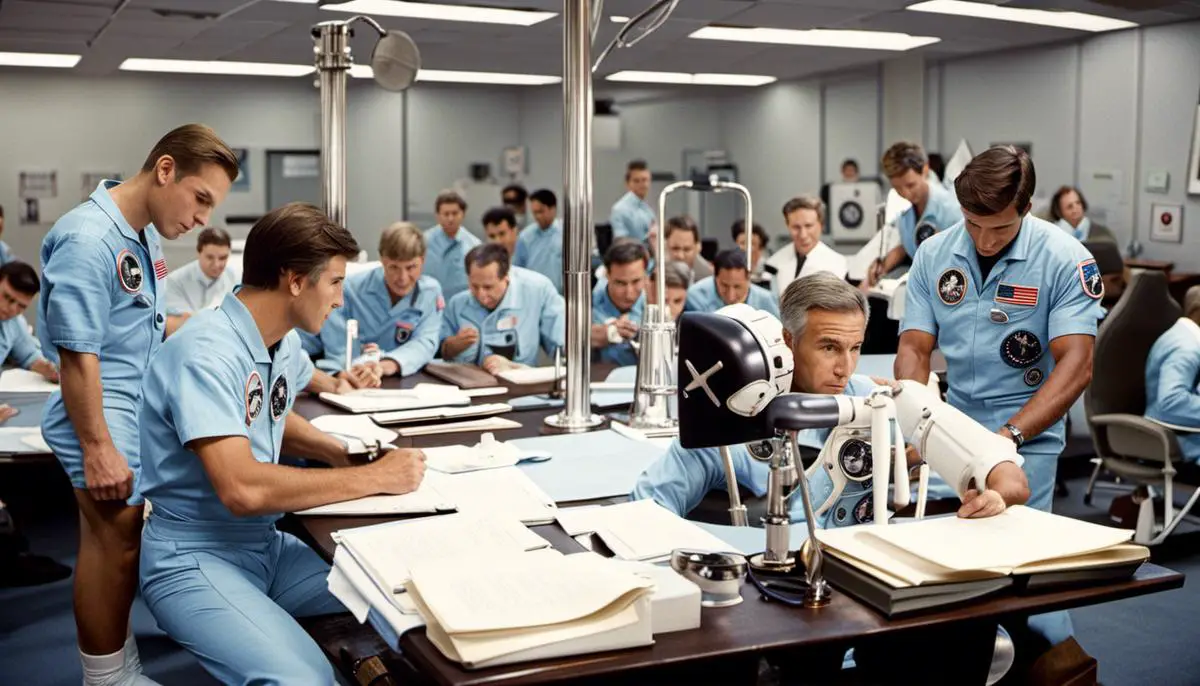As one of mankind’s most ambitious endeavors, the Apollo missions required meticulous planning, audacious courage, and unerring precision. Central to these monumental feats was the crew selection process, which was underscored by an intricate interplay of various factors.
Given the challenging and potentially hazardous nature of space travel, the process involved stringently defined selection criteria, which aimed at ensuring the safety and success of the missions.
This journey not only tasked the United States in its scientific capabilities, but was also a significant facet of the political contest between the US and Soviet Union during the fraught Cold War era.
The journey of crew selection transcended the realms of mere physical health and mental fortitude, delving into extensive training routines and skill assessments, with each step designed to prepare the candidates for the rigors of space.
Contents
The Need for Specific Selection Criteria
The Complexity and Danger of Space Travel
To understand the crew selection process for Apollo missions, one must first appreciate the challenging and precarious nature of space travel.
Venturing into outer space exposes astronauts to extreme conditions, such as zero gravity, cosmic radiation, isolation, confinement, and circadian rhythm disruptions. The spacecraft is also subjected to intense forces and temperatures during launch and re-entry into Earth’s atmosphere.
Therefore, astronauts must be in peak physical condition to withstand these conditions and mitigate the inherent risks. Knowledge and training in engineering, navigation, computers, and survival skills are also critical, with any deficits potentially leading to catastrophic failure.
This necessity for an exhaustive skill set and robust health comprises a significant portion of why NASA’s selection criteria for astronauts is so stringent.
Cold War: A Different Battle Ground
Simultaneously, the Apollo missions were taking place in the heart of the Cold War, adding political pressure to the scientific and exploratory objectives.
This time period, post-World War II and stretching into the late 20th century, was characterized by intense rivalry between two global superpowers – the United States and the Soviet Union. The competition also extended to space, infamously known as the “Space Race”.
The US was determined to assert their dominance in space technology and prove their supremacy over the Soviet Union. These high-stakes lent the Apollo missions – especially Apollo 11, the first to land humans on the Moon – significant symbolic and strategic value.
Thus, selecting the right crew was crucial, as the astronauts weren’t just explorers but representatives of American prowess, resilience, and innovation on a global stage.
Under Intense Scrutiny: The Astronaut Selection Process for Apollo Missions
The crew selection for the historic Apollo missions unfolded against a backdrop of intricate technical demands and global geopolitical tension.
The objective was clear – to identify the finest individuals capable of excelling even under the most strenuous circumstances. This arduous, meticulous selection process encompassed detailed physical examinations, deep psychological evaluations, thorough interviews, and demanding training sessions.
An astronaut candidate would need to satisfy stringent eligibility requirements, which included specific age, height, and weight parameters, along with superior physical health and excellent eyesight. They were also mandated to possess a degree in either engineering, biological science, physical science, or mathematics, and a specific quantum of flying experience.
A centerpiece of this selection was the psychological evaluation. The reality of spending days in isolation inside a cramped spacecraft and having to confront unending perils required particular mental fortitude. Consequently, NASA was keen to select individuals who demonstrated remarkable resilience, adaptability, teamwork spirit, and the ability to manage high-stress situations gracefully.
The astronauts, once selected, were subjected to robust training regimes to prepare them for the mission. These training modules varied from theoretical classroom sessions to physically intense exercises such as zero-gravity simulations and survival training. The latter prepared them to face potential emergency landing situations effectively.
These painstaking selection criteria and training initiatives were crucial to confirming the mission-readiness of each astronaut. They were also symbolic of America’s impressive talent pool and capabilities, displayed to the world stage.

Physical and Psychological Considerations
The Physical Imperatives of Space Travel
Embarking on a space journey, even for astronauts at their physical peak, is an incredibly challenging affair. The inhospitable environment of space, with zero gravity, harmful radiation, isolation, and confinement, can significantly impact the human body.
During the Apollo missions in the 1960s, astronauts had to pass a gamut of rigorous physical examinations to certify that they could withstand the physical demands of space travel and survive within the brutal space environment.
Space travel induces a series of physiological changes in astronauts. With zero gravity, muscle mass and bone density drop, cardiovascular capacity changes, while vestibular functions critical for balance and spatial orientation get severely compromised.
It was, therefore, crucial that astronauts remained in peak physical condition to counter these physical challenges. As part of the crew selection process for the Apollo missions, the astronauts were usually subjected to demanding endurance trials, rigorous strength tests, and detailed medical checks.
Mental Fortitude Above the Clouds
Just as important as the physical tests, however, were the psychological evaluations. Astronauts during the Apollo missions were not just physically fit but also possessed a calm, problem-solving temperament, high-stress tolerance, and the ability to work harmoniously in a group under adverse conditions.
The isolation and confinement of space can trigger a plethora of psychological issues, including loneliness, depression, stress, and interpersonal friction. It was vital that the Apollo astronauts could handle these pressures. They underwent rigorous psychological assessments, involving personality and intelligence testing, psychiatric interviews, and simulations of the space environment to assess their coping mechanisms.
Simulating the Rigors of Space
NASA used various methods to simulate the mental and physical effects of space travel during the crew selection process. Potential astronauts were subjected to a battery of tests and simulations that mimicked the space environment as closely as possible.
These simulations tested both the physical and psychological resilience of the astronauts. They included experiencing prolonged periods in a small, cramped cabin, isolation and confinement, sensory deprivation, and living in close quarters with others.
The goal was to prepare the astronauts for the extreme conditions of space travel and to ensure they were up to the challenge they would face once they were out there.
Candidates would be observed during these mock missions, with a keen eye not only for their physical responses but also for signs of psychological stress and how well they worked in a team. Anyone who showed signs of physical weakness or whose behavior indicated they might not be able to handle the psychological challenges of a real space mission would not make the cut.
Surviving Harsh Simulations and Brutal Environments
In anticipation of the multitude of challenges that astronauts would confront in space, candidates vying for a spot on the Apollo missions were put through a battery of simulation exercises that went above and beyond typical physical and mental evaluations.
These trials meticulously replicated the grueling conditions of a space mission, subjecting trainees to high G-force experiences in centrifuges, weightless environments in zero-G planes, and enduring periods of isolation in simulated space capsules.
The intent behind these stringent tests was to cut those who could not withstand the physical and emotional pressures of an actual space journey, thereby ensuring that only candidates with excellent physical health and robust mental resilience were chosen for the revered Apollo missions.

Training and Skills Assessment
Tough Training Regimens
Next to surviving grueling simulations, an integral part of the Apollo crew preparation was enduring an intensive training regimen. This rigorous program was not just about physical fitness, but held the all-encompassing purpose of equipping the astronauts to survive and adapt to the hostile conditions of space, including living in zero gravity and withstanding severe temperature fluctuations.
Importantly, it aimed to establish a comprehensive skill set that would enable crew members to operate in a completely alien environment, such as that of the moon’s surface.
Survival Training
A fundamental aspect of this training program was survival training. Candidates were taught survival skills to allow them to withstand unplanned landings on water or terrestrial areas. Lessons included wilderness survival, rafting, and other water survival techniques in case the crew’s return capsule missed the primary recovery zone and ended up in remote locales.
Technical Skill Assessment
Also incorporated into the training regimes were technical skill assessments. Given the highly technical nature of spacecraft, candidates needed to possess strong aptitude in fields like engineering, geology, and physics. More importantly, these candidates needed to excel in quick problem-solving situations that were typical in spaceflights. Their ability to troubleshoot issues in real-time had the potential to avert catastrophic outcomes.
Simulated Space and Lunar Conditions
The crew selection process also utilized simulations that could imitate various space and lunar conditions. These took on formidable challenges such as controlling a spacecraft, adapting to weightlessness, and executing lunar landings.
Such simulations sought to not only test the astronauts’ skills and mental abilities to their maximum but also to ensure they could maintain their composure in extraordinarily stressful situations.
Teamwork and Problem-Solving Abilities
Perhaps of equal importance as technical skills in the crew selection process was an emphasis on teamwork and problem-solving abilities.
The Apollo mission teams were comprised of just three astronauts, so harmonious interaction between crewmates was crucial. Astronauts were often presented with simulated challenges that required them to find effective solutions through teamwork. Moreover, honing in on the problem-solving aspect, NASA sought individuals who were adept at making sound decisions in time-critical situations.
Mechanical Aptitude Evaluation
Additionally, mechanical aptitude was put to the test for those hoping to be selected for the Apollo missions. Astronauts would need to handle specialized equipment and machinery on board the spaceship and lunar module.
Candidates were therefore required to display not only a thorough understanding of such devices but also the finesse of handling and maneuvering them in space.
Conclusion
In considering the selection process for astronauts for the Apollo missions, we quickly come to understand the complexity and nuance of these programs; physical strength and technical prowess were certainly factors, but not the only ones.
The astronauts also needed to display immense mental determination, resilience, and the ability to problem-solve efficiently under extreme duress. These rigorous selection procedures and thorough training programs were key in ensuring the success of the historic Apollo missions.

The Deciding Factors
Physical and Mental Health Requirements
When examining how astronauts were selected for the Apollo missions, a major consideration was undoubtedly the physical and mental health capabilities of the candidate. Astronauts were required to be in perfect physical condition in order to endure the demanding nature of space travel, which includes discomfort during takeoff, challenges of living in a zero-gravity environment, and the extreme risks associated with spacewalks or lunar expeditions.
Potential crew members were subjected to exhaustive physical checks and tests to measure their cardiovascular, lung, and overall physiological fitness, including their ability to withstand high gravitational forces and oxygen saturation imbalances.
Mental and emotional resilience were also paramount to the selection process. Astronauts were expected to withstand periods of confinement and isolation in space, requiring a great deal of mental stability. Special emphasis was also placed on problem-solving skills and the capacity to maintain patience under high stress-conditions.
Selection Based on Skills, Experience and Personal Qualities
The crew selection process for these early Apollo missions heavily emphasized skills and experience. NASA wanted astronauts who had impeccable records as test pilots, as they could keep their cool under pressure, make rapid critical decisions, and effectively deal with equipment malfunctions or other unexpected events during the mission.
The astronauts’ academic qualifications were also taken into account, with backgrounds in fields such as engineering, medicine, biology, or physics seen as particularly valuable. They were expected to conduct scientific experiments and observations, and troubleshoot any technical issues that might arise on the spacecraft. Leadership skills and the ability to work well in a teamwork environment were also deemed crucial.
Roles and Responsibilities
The number and roles of astronauts aboard a mission significantly affected crew selection. Each Apollo mission consisted of a crew of three: the Command Module Pilot, Lunar Module Pilot, and Commander. The Command Module Pilot was responsible for piloting the Apollo spacecraft on its own and in conjunction with the Lunar Module.
The Lunar Module Pilot worked with the Commander during the lunar landing phase of the mission. The Commander, being the mission’s commanding officer, held prime responsibility for the success of the mission. The roles required different skillsets and the balancing of these roles were integral to the selection process.
The Influence of Politics and Personal Dynamics
Selecting crew members for the Apollo missions was not just about individual qualifications. NASA also had to take into account the subtle interplay of politics and personal dynamics. There was an unwritten rule of crew rotation, where backups for one mission would be slated to fly the next. This was, however, not an infallible rule and was subject to change based on the needs of the mission and the astronauts’ performance in training.
In addition, critical to the crew’s success was how well the members could work together- their ability to communicate effectively, resolve disagreements, and remain collectively focused on the mission’s objectives. Personal dynamics and crew compatibility were elements NASA seriously considered during the selection process.
Balancing Priorities and Objectives
Crew selection for the Apollo missions was thus a dynamic and complex process. Changes in mission parameters, technological advancements, and even broader political considerations could affect the final decisions.
Balancing the individual’s health, skills, and experience with the crew’s overall balance, cohesion, and the objectives of the mission was an on-going challenge.
Ultimately, those who were chosen had to embody an extraordinary combination of physical fitness, technical expertise, determination, and the ability to work as part of a team under intensely stressful conditions. In the end, the crew of each Apollo mission represented the culmination of a selective process that wound its way through a maze of competing demands and strategic considerations.

By delving into the intricate process behind the Apollo mission’s crew selection, one can appreciate the stringent measures implemented to ensure the United States’ success and supremacy in the space race. The intense training programs, rigorous physical and psychological evaluations, and thorough skill assessment illustrate an indefatigable pursuit of excellence and safety.
Beyond their physical health and skill set, an astronaut’s personal qualities and interactions amongst their peers played a vitally shifting role in the final decision. The Apollo missions’ story, therefore, is a testament to the indomitable human spirit, the relentless pursuit of knowledge, and the unfettered vision for pioneering frontiers beyond our earthly confines.

With a passion for unraveling the mysteries of the moon, Dr. Luna Sterling is a highly-respected astrophysicist, a dedicated lunar enthusiast, and a captivating blogger. After earning her Ph.D. in Astrophysics from the Massachusetts Institute of Technology (MIT), she served as a lead scientist and mission planner for NASA, contributing significantly to various lunar missions.
For over two decades, Luna has been at the forefront of lunar science, pushing boundaries and pioneering discoveries that have enriched our understanding of the moon’s geological history. However, it’s her infectious enthusiasm for all things lunar that truly sets her apart.
In an endeavor to bring the moon closer to everyone, Luna started her blog, “Luna’s Lens: A Closer Look at the Moon.” With this platform, she offers a unique blend of intriguing moon facts, updates on lunar missions, and personal anecdotes from her experiences in the field, all told in an engaging and accessible manner.
Luna’s unique blend of scientific expertise and warm, humorous writing style has transformed complex astrophysics into compelling narratives that captivate her audience. As a gifted communicator, she leverages her knowledge and experience to relate scientific facts to everyday life, thus making her blog a must-read for both seasoned space enthusiasts and curious newcomers.
Interactive and inviting, Luna frequently encourages reader engagement through thought-provoking discussions and a monthly ‘Ask Dr. Luna’ feature, where she personally answers questions about the moon and space exploration. A celestial storyteller at heart, Dr. Luna Sterling’s passion for the moon is as vast as the cosmos she explores, making her an invaluable beacon in the world of lunar science.
